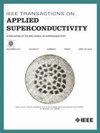Current Transmission and Resistance Characteristics of Bridge Joints in Three-Phase Coaxial Superconducting Cables
IF 1.7
3区 物理与天体物理
Q3 ENGINEERING, ELECTRICAL & ELECTRONIC
引用次数: 0
Abstract
In the design and manufacturing process of intermediate joints for three-phase coaxial superconducting cables, optimizing the joint structure and minimizing resistance loss are essential to improving transmission efficiency and long-term stability. However, the concentric connection of superconducting functional layers of all three phases at the intermediate joint creates a resistance-concentrated region, leading to higher thermal loads and increased quenching risk. Currently, most research on superconducting tape joints focuses on lap joints. However, for the connection of the superconducting layer in intermediate joints, bridge joints are more advantageous. Bridge joints can address the issue of reversed tape orientation that often occurs in lap joints, enabling a more symmetric current transmission path. Thanks to their symmetrical structure and flexible welding orientation, bridge joints are better suited to meet the integrated performance requirements of joints in complex systems. This design facilitates compact system layouts and is more appropriate for large-scale industrial deployment in complex installation environments. Through experimental and simulation analysis of the current transmission behavior and resistance-influencing factors of bridge joints in three-phase coaxial superconducting cables, this study reveals that the current transmission efficiency in the superconducting layer bridge joint region is directly related to the geometric configuration of the joint. Among the configurations, the face-to-face design demonstrates superior current-carrying capacity due to its more direct current transmission path. This research provides theoretical guidance for optimizing the design of superconducting joints and improving the stability and performance of superconducting cables in practical applications.三相同轴超导电缆桥接电流传输及电阻特性
在三相同轴超导电缆中间接头的设计和制造过程中,优化接头结构,减小电阻损耗,是提高传输效率和长期稳定性的关键。然而,在中间接头处,三相超导功能层的同心连接形成了一个电阻集中区域,导致热负荷增大,淬火风险增大。目前,对超导带接头的研究大多集中在搭接上。而对于中间接头中超导层的连接,采用桥式接头更为有利。桥接接头可以解决搭接接头中经常出现的带方向相反的问题,从而实现更对称的电流传输路径。桥梁接头具有对称的结构和灵活的焊接方向,可以更好地满足复杂系统中接头的综合性能要求。这种设计便于紧凑的系统布局,更适合复杂安装环境下的大规模工业部署。本研究通过对三相同轴超导电缆桥接头电流传输行为及电阻影响因素的实验和仿真分析,揭示了超导层桥接头区域电流传输效率与接头几何构型直接相关。在这些配置中,面对面设计由于其更直接的电流传输路径而具有更优越的载流能力。该研究为实际应用中超导接头的优化设计,提高超导电缆的稳定性和性能提供了理论指导。
本文章由计算机程序翻译,如有差异,请以英文原文为准。
求助全文
约1分钟内获得全文
求助全文
来源期刊

IEEE Transactions on Applied Superconductivity
工程技术-工程:电子与电气
CiteScore
3.50
自引率
33.30%
发文量
650
审稿时长
2.3 months
期刊介绍:
IEEE Transactions on Applied Superconductivity (TAS) contains articles on the applications of superconductivity and other relevant technology. Electronic applications include analog and digital circuits employing thin films and active devices such as Josephson junctions. Large scale applications include magnets for power applications such as motors and generators, for magnetic resonance, for accelerators, and cable applications such as power transmission.
 求助内容:
求助内容: 应助结果提醒方式:
应助结果提醒方式:


